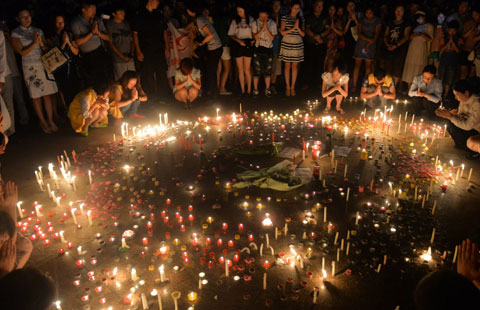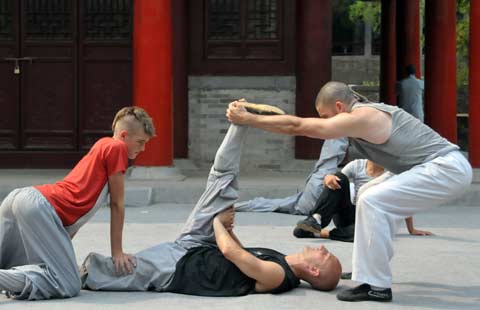Wired to wow
Updated: 2014-08-28 07:05
(China Daily)
|
|||||||||||
|
 |
|
For pictures of students training, rehearsal and performance at Youth Olympics show. |
Students of major martial arts school endure tough training for high-wire act at Youth Olympics show, report Sun Xiaochen in Nanjing and An Baijie in Dengfeng, Henan.
|
School of hard knocks Like many fellow Americans, Colin Malick used to think kung fu was more of a "Hollywood thing" rather than martial arts. But after arriving in China last year and taking up lessons at the Shaolin Tagou International Communication Center in Dengfeng for eight months, the 23-year-old has realized that kung fu is not child's play. Malick, from the US state of Oregon, said he trains for six to eight hours every day. "We have to get up at about 5:30 am and run 3 km to the Shaolin Temple to exercise before breakfast," he said. Malick became interested in martial arts after watching movies of kung fu star Jackie Chan. His father's girlfriend, who is Chinese, told him to learn Shaolin kung fu. Malick said his dream is to become a police officer, and learning martial arts can improve his physical condition. His martial arts course costs about $10,000 a year, with the training fees, accommodation and food included. There are currently 11 foreign students learning martial arts at the center and 9,800 foreigners have studied there since 1997. By performing at many international events, the center has attracted more international students, said Liu Baoshan, founder of the Shaolin Tagou Education Group. Won Zong, a 15-year-old Korean-Frenchman, said that he was studying Shaolin martial arts under the orders of his mother to become more independent. The campus is better than what he had expected, he said. Shen Jia, a coach for the international students, said that some foreign students were homesick at the beginning, but he always encourages them to persevere. "Many foreign students thought that it would be fun to learn martial arts, but actually it's tough and tedious," he said. "After all, Shaolin Temple is not Hollywood." By An Baijie |
"I knew we did it because we heard the cheers from the crowd (while being hoisted up). But when I saw the entire show on TV, I was like 'Wow! How did we manage to do it?'
"All the pain and sweat paid off."
Yuan, 17, is a student of the Shaolin Tagou Martial Arts School near the famed Shaolin Temple.
Despite the heavy rain on Aug 16, Tagou's high-wire act featuring 120 highly trained martial arts students in various stunts and formations drew thunderous applause from the 60,000-strong crowd in the Nanjing Olympic Sports Center Stadium.
Many fans started looking forward to the students' next performance, this time at the closing ceremony of the Youth Olympic Games on Thursday.
But Tagou's heart-stopping performance in a perilous downpour also generated controversy.
When reporters later asked about the risks involved in the acts, opening ceremony director Chen Weiya said the show would go on "even if blades rained from the sky".
Chen's remarks drew intense criticism but the student performers supported their director.
"If the show had been canceled because of the heavy rain even though we had practiced and gone through the rehearsals, it would have been the ultimate disrespect for our hard work," Yuan said.
"We've come so far in preparing for the show and we won't let anything stand between us and its perfect completion."
Practice makes perfect
The Shaolin Tagou Martial Arts School picked the final 120 performers for the show from 35,000 students through a strict selection process that assessed their strength, flexibility and stamina, after accepting the assignment from the Games organizers on March 8.
Before arriving in Nanjing for the in-stadium practice on July 1, Yuan and his peers had practiced day and night in Henan province for more than 100 days, mostly to build their strength and flexibility.
Starting at 8 am, students went through three training sessions in the morning, afternoon and evening, spanning almost 10 hours excluding meal breaks.
The training was much more intense than what they were used to in regular classes.
According to Miao Pandeng, one of the school's coaches, students had to complete 500 push-ups and 500 sit-ups every day to improve their arm, abdomen and lower back strength to be able to switch formations while being hoisted on wires without support.
It was grueling work for what amounted to a mere 10 minutes on stage.
Although the official final performance featured 30 different stunts and moves in the air, students prepared for more than 100 options on the ground.
The biggest challenge was getting used to the handstand position, which had to be maintained for as long as 30 seconds in the official show.
"It's really hard to maintain the pose while staying composed and hung up in the air. You can easily get dizzy and throw up at the beginning," said Huang Yikai, another 18-year-old student performer in the show.
To overcome the "upside-down" challenge, students practiced handstands on the ground in pairs. One student kept the pose while another would hold his feet for at least one minute before taking turns. They completed eight such sets in every morning session.
"It's actually not that hard for us to hold the handstands as that's one of the fundamentals for martial arts. But to do so for that long and at that height, that's really tough to get used to," Huang said.
Another challenge came from being hoisted on the wires. Hoisted high in the air for about two hours a session, Yuan, who has practiced martial arts for three years, said he suffered from periodic numbness in his thighs as the harness that raised him was too tight.
"Sometimes you couldn't even feel your legs after a day's practice," he said.
Today's Top News
Putin, Poroshenko hold first bilateral meeting
Panda fakes pregnancy for more buns
Two execs at VW's ventures in China probed for 'serious' violations
'Great Wall' takes a hit at US boxing
Russian soldiers' capture clouds talks
Leaders clash in debate before Scotland vote
US prepares military options in Syria
Aussie MP apologizes to Chinese
Hot Topics
Lunar probe , China growth forecasts, Emission rules get tougher, China seen through 'colored lens', International board,
Editor's Picks

|

|

|

|

|

|





